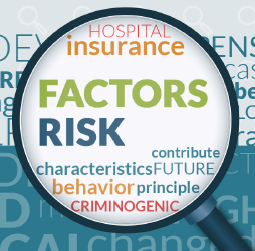This is the 6th of a 7 part series on The Risk Principle Simplified. Subscribe to our blog and get the series delivered right to your inbox.
What factors contribute to risk?
Just like the insurance industry, the risk model for offenders has very specific factors to consider. These models were developed in the exact same way that life insurance risk levels are determined. The life insurance industry looks at factors that correlate with early death. The criminal risk model looks at factors that correlate with future criminal behavior. Similarly, some of these factors can be changed (“dynamic risk factors” or “needs”) and others are static. Our next white paper, The Need Principle Simplified, will address “The Key 3” and how various offender situational and personal characteristics interact to increase or decrease criminogenic risk.
When High Risk is Too High: The Psychopath
Imagine what you would be capable of if you were completely self-interested and did not experience fear or guilt. While it is tough to even imagine, it is safe to say that your behavior would change dramatically. Such is the world of the psychopath, and if you haven’t already supervised or treated one in your community corrections agency, you will soon.
Like most things in life, the expansion of community corrections ushers in positives and negatives. The positives include decreased cost, reunited families, superior treatment opportunities, and increased ability for offenders to maintain employment. The down sides include the need for zoning for new facilities while dealing with the Not In My Backyard (NIMBY) Effect and, of vital importance, the need for increased acknowledgement of, and recognition of, psychopathy. When community corrections was a smaller player in the criminal justice field, the need for evaluation of psychopathy was limited. That is no longer the case. With an increasing percentage of offenders going through community corrections of some sort, the likelihood of the presence of a psychopath increases.
Psychopaths generally do not experience emotions, remorse, or empathy. In extreme cases, they do not care whether you live or die as long as their needs are met in the meantime. Professor Robert Hare is a Canadian criminal psychologist, and the creator of the Psychopathy Checklist-Revised (PCL-R), a highly specialized psychological assessment used to determine whether someone is a psychopath. Credited with coining the term “psychopath”, Dr. Hare has interviewed and researched this population of predators in prison and elsewhere for decades.
He explains: "It stuns me, as much as it did when I started 40 years ago, that it is possible to have people who are so emotionally disconnected that they can function as if other people are objects to be manipulated and destroyed without any concern."
While not all psychopaths are violent (or even involved in the criminal justice system), many are. They are highly likely to create new victims and can wreak havoc on a community corrections agency and staff. Assessment is not a simple task and the PCL-R should not be used unless specialized training is obtained. Many psychopaths get worse with treatment and attempting to engage them in treatment based on empathy and/or relationships is a waste of time. Given their degree of selfishness, the only angle that has any promise is one borne out of self-convenience and self -centeredness. Group therapy should be avoided as their contamination of other clients is remarkable.
Psychopathy is not a difference in degree of risk. It is a different animal and should not be taken lightly. In short, every community corrections agency should have access to a professional trained and skilled in psychopathy evaluation. If you wait to discover it the hard way, the consequences will be felt by many people for a long time. All community corrections administrators should begin by reading “Without Conscience: The Disturbing World of the Psychopaths Among Us” by Robert Hare. Hare.org is a great resource for information and training opportunities.
In our next blog in this series, we will conclude with author commentary on the Risk Simplified series. Subscribe to our blog and get the series delivered right to your inbox.



